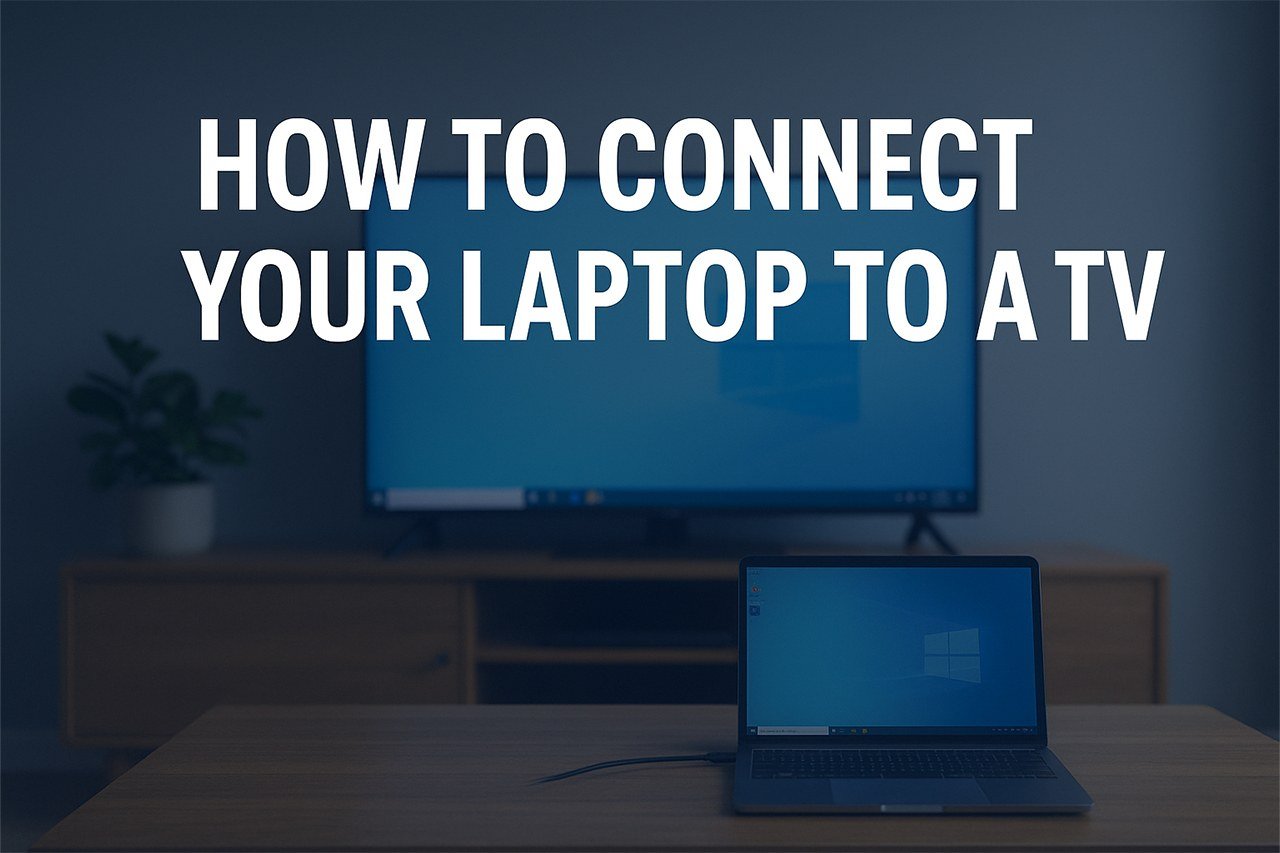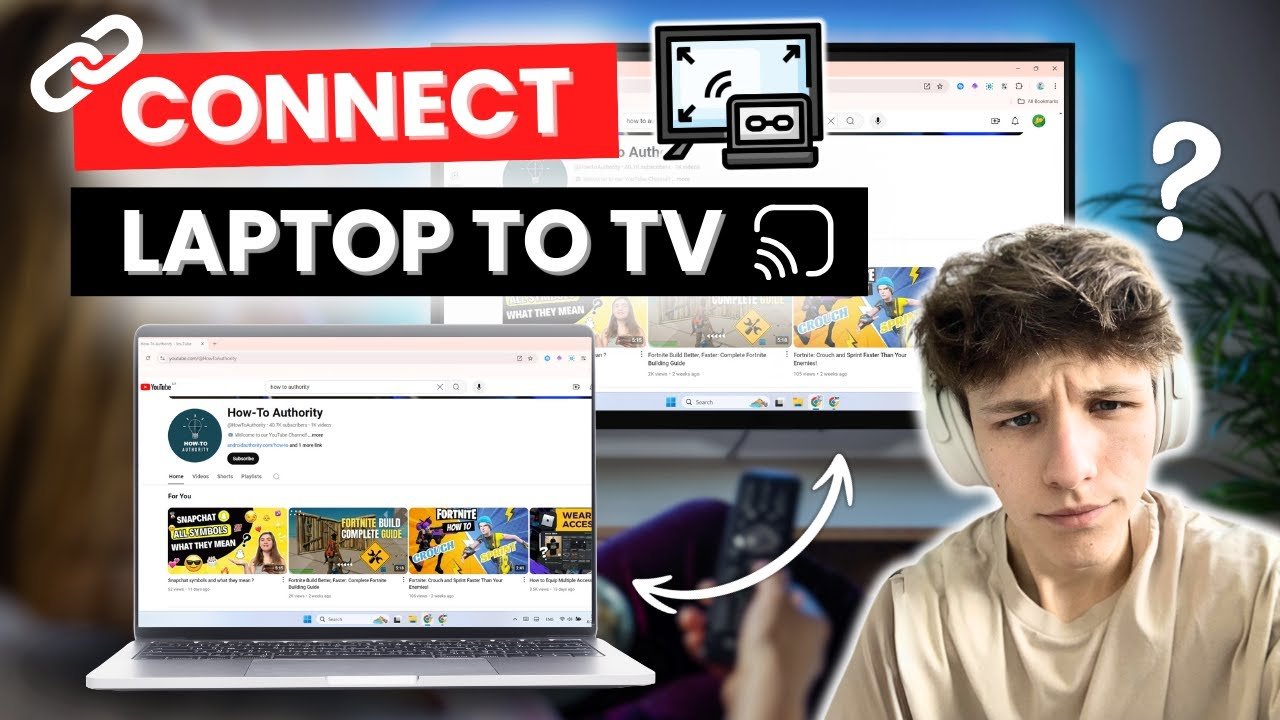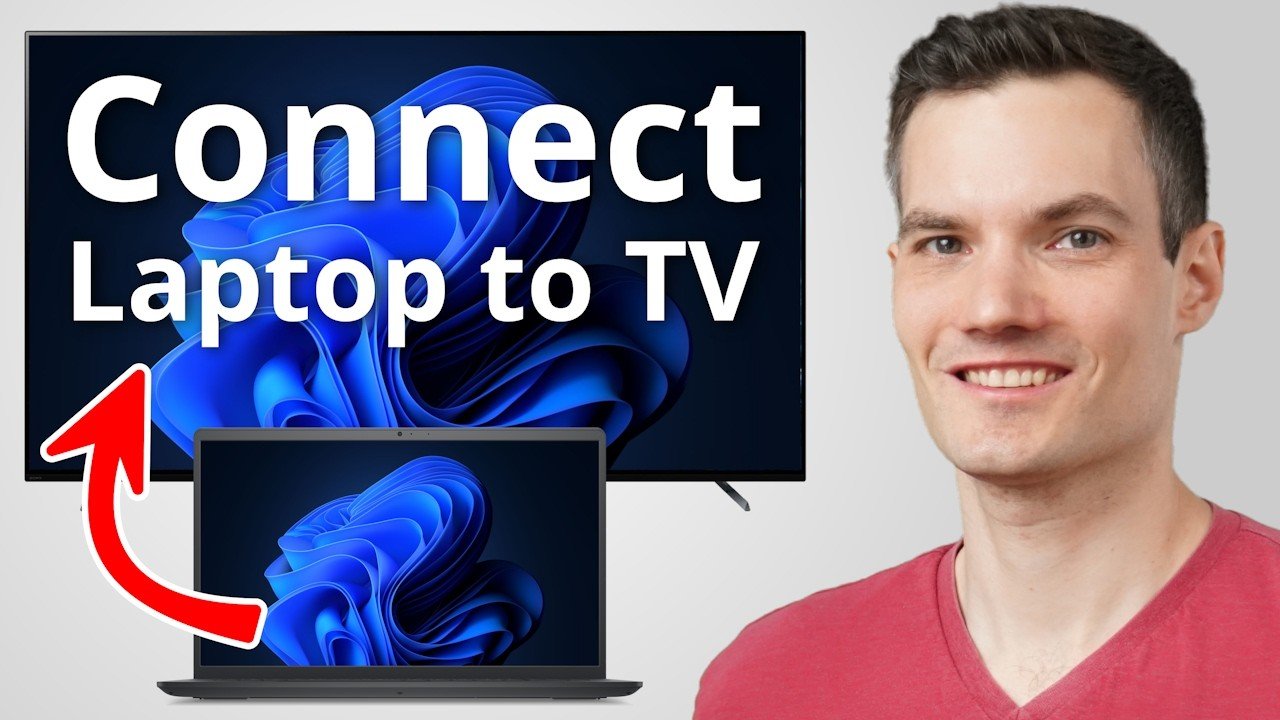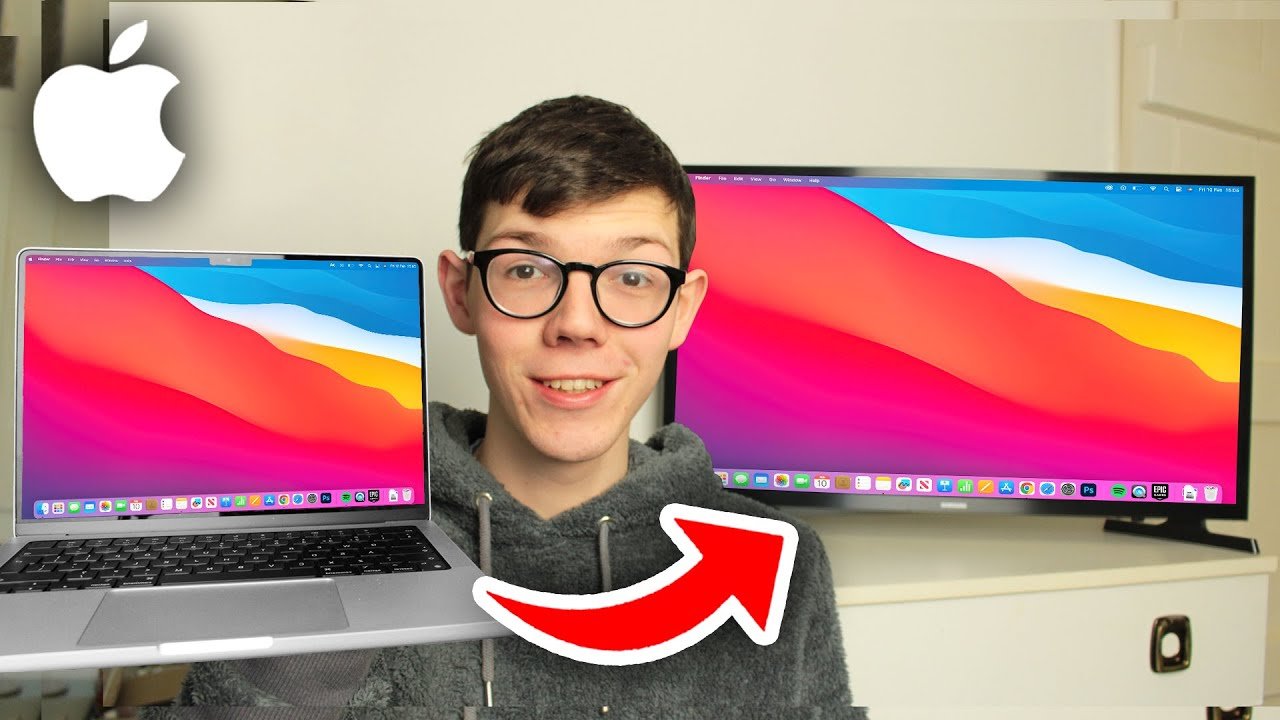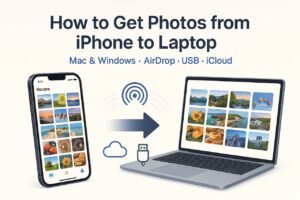Ever wondered how a laptop connects to a TV without the hassle of trial and error? It’s simpler than it looks, and once you know the options, you can choose the method that works best for your setup.
A laptop connects to a TV either with a wired connection, such as HDMI or USB‑C with the right adapter, or wirelessly through technologies like Miracast on Windows or AirPlay on macOS. Wired connections give the most reliable video and audio quality, while wireless options offer flexibility and convenience when both devices support the same standard.
This guide walks through both approaches step by step. It covers HDMI and other cables, older connection methods, wireless casting options, Apple’s AirPlay, display and audio settings, and troubleshooting tips to keep everything running smoothly.
Wired Connections: HDMI and Beyond
Wired connections give the most stable way to link a laptop to a TV. They avoid lag, deliver reliable video and audio, and usually work with minimal setup. Choosing between HDMI, USB-C, or DisplayPort depends on the laptop’s ports and the TV’s inputs.
Using an HDMI Cable
Most laptops and TVs have an HDMI port, making this the simplest method. An HDMI cable carries both video and audio in one line, so there’s no need for a separate audio cable.
To connect, plug one end into the laptop and the other into the TV. Then switch the TV input to the correct HDMI channel. On the laptop, open display settings to extend or duplicate the screen.
Quick tips for HDMI:
- Use a cable labeled High-Speed HDMI for 1080p or 4K.
- Keep the cable under 15 feet for best signal quality.
- If the laptop has only mini-HDMI, use an HDMI adapter.
This method is reliable because it avoids wireless interference and works instantly in most setups.
Connecting with USB-C to HDMI
Newer laptops often skip HDMI ports and use USB-C instead. With the right USB-C to HDMI adapter or cable, users can still connect directly to a TV.
Not all USB-C ports support video output. Look for a small DisplayPort or Thunderbolt symbol next to the port. Without this, the adapter won’t work.
Steps are simple:
- Plug the adapter into the USB-C port.
- Connect an HDMI cable from the adapter to the TV.
- Adjust display settings to set screen mode.
USB-C to HDMI is handy because it supports high resolutions, often up to 4K at 60Hz. It also works with docking stations, letting people connect multiple displays and devices at once.
DisplayPort and Mini DisplayPort Options
Some laptops include DisplayPort or Mini DisplayPort instead of HDMI. These ports also carry video and audio, but TVs rarely have them built in. That’s why most people need a DisplayPort to HDMI adapter.
DisplayPort supports higher refresh rates and resolutions than HDMI in many cases. Gamers often prefer it for smooth playback. However, for a living room TV, HDMI is usually enough.
Here’s a quick comparison:
| Port Type | Common Use | Adapter Needed for TV? | Max Resolution (typical) |
|---|---|---|---|
| HDMI | TVs, monitors | No | 4K @ 60Hz |
| DisplayPort | Monitors, gaming | Yes (to HDMI) | 8K @ 60Hz |
| Mini DisplayPort | Older laptops/Macs | Yes (to HDMI) | 4K @ 60Hz |
Using the right adapter ensures compatibility without losing video quality.
Troubleshooting Wired Connections
Sometimes the TV shows no signal even when the cable is connected. The first step is checking if the TV input matches the port used. Many people forget to switch from HDMI1 to HDMI2.
If the laptop still doesn’t detect the TV, open display settings and click “Detect” or “Identify.” Updating graphics drivers can also solve recognition issues.
Other fixes include:
- Testing with another HDMI cable.
- Making sure the adapter supports video output.
- Restarting both the laptop and TV.
For audio, confirm the TV is set as the default playback device in sound settings. Simple checks like these usually fix most wired connection problems.
Alternative Wired Methods: Old School Solutions
Not every TV or laptop has the latest ports, so older wired methods can still come in handy. These setups may not deliver the sharpest picture or carry audio by default, but they remain practical when modern connections like HDMI or USB-C are not available.
VGA Cable Connections
A VGA cable is one of the oldest ways to connect a laptop to a TV. It only carries video, so users will need a separate audio solution. Most laptops built before the mid-2010s included a VGA port, and many older TVs still support it.
The main drawback is resolution. VGA is analog, so image quality is lower compared to digital connections. Expect 720p or 1080p at best, and sometimes fuzzy text.
When setting up, users should:
- Plug the VGA cable from the laptop to the TV.
- Switch the TV input to “PC” or “VGA.”
- Adjust screen resolution in display settings for the clearest picture.
This method works fine for slideshows, browsing, or casual streaming but isn’t ideal for high-definition movies.
DVI to HDMI Adapter Use
Some laptops and desktops feature DVI ports, which also only carry video. By using a DVI to HDMI adapter, users can connect to a TV’s HDMI input. This setup provides better image quality than VGA since DVI is digital.
HDMI supports both video and audio, but DVI does not. That means video will display on the TV, but sound won’t transfer unless an additional audio connection is made.
A simple setup looks like this:
| Port on Laptop | Adapter Needed | TV Connection | Carries Audio? |
|---|---|---|---|
| DVI | DVI to HDMI | HDMI | No |
This option is useful when the laptop lacks HDMI but has DVI, and the TV only accepts HDMI inputs.
Adding an Audio Cable for Sound
Because VGA and DVI don’t carry audio, users will need an audio cable to get sound from the laptop to the TV. The most common solution is a 3.5mm stereo cable, the same type used for headphones.
Steps are simple:
- Plug one end into the laptop’s headphone jack.
- Connect the other end to the TV’s audio-in port (usually next to the VGA or HDMI input).
- Set the TV’s input source to match both video and audio.
Without this cable, the TV will show the picture but play no sound. For a better experience, some people connect the cable to external speakers instead of the TV, especially since older TVs often have weaker built-in audio.
Wireless Connections: Cutting the Cord
A laptop can mirror or cast to a TV without cables using built‑in wireless display features or add‑on devices. The best option depends on the laptop’s operating system, the TV’s compatibility, and whether low latency or simple setup matters most.
Miracast for Windows Laptops
Miracast comes built into most Windows 10 and Windows 11 laptops. It allows direct screen mirroring from the laptop to a TV that supports Miracast. Both devices need to be on the same Wi‑Fi network, and the TV must have Miracast enabled.
The setup is simple: right‑click the desktop, open Display settings, and select Connect to a wireless display. The TV appears in the list, and once chosen, the laptop screen mirrors instantly.
This method is best for watching videos, browsing, or presentations. However, Miracast can show slight lag, which makes it less ideal for fast‑paced gaming. According to Windows Forum, Miracast works well for casual use but may struggle with compatibility on older TVs.
Quick facts about Miracast:
- Built into most Windows laptops
- Works over Wi‑Fi Direct (no router required)
- Supports full HD video and audio
- Some TVs may need a firmware update
Chromecast and Google Cast Devices
Chromecast is a small device that plugs into a TV’s HDMI port. Once set up, it allows laptops to cast content using Google Chrome or supported apps. Unlike Miracast, it doesn’t mirror the entire screen by default but streams specific tabs, apps, or videos.
Setup takes only a few minutes. The Chromecast connects to Wi‑Fi, and the laptop uses the Chrome browser’s Cast option to send content. This makes it especially useful for streaming YouTube, Netflix, or Google Slides.
A key advantage is that once casting starts, the laptop can multitask while the TV continues streaming. Chromecast also supports 4K on certain models, making it a flexible option for media lovers. Guides like The Geeks Club explain how Chromecast works alongside Miracast and other wireless display methods.
Pros of Chromecast:
- Works across Windows, macOS, and mobile devices
- Supports app‑based casting and full screen mirroring
- Affordable and easy to set up
Wireless Display Adapters
For TVs without built‑in wireless display support, a wireless display adapter provides a simple fix. These dongles plug into HDMI and USB ports on the TV and add Miracast or similar features.
Microsoft’s Wireless Display Adapter is one of the most common options. It turns any HDMI‑equipped TV into a Miracast‑ready display. Once connected, laptops can mirror screens just like they would with a native Miracast TV.
These adapters are helpful for older TVs or projectors that lack smart features. They usually support 1080p resolution, and some newer models handle 4K. As Anker points out, adapters solve compatibility issues when built‑in wireless display options fail.
When to use a wireless display adapter:
- TV doesn’t support Miracast or Chromecast
- Need a portable solution for travel or work presentations
- Want a plug‑and‑play setup without replacing the TV
Adapters extend the life of older TVs and make wireless screen mirroring accessible without buying a new device.
Apple Solutions: AirPlay and MacBook Magic
Apple gives MacBook users an easy way to connect to a TV without cables. With AirPlay, they can stream video, mirror their screen, or even use the TV as a second display. The process depends on having the right setup and making sure the TV or device supports the feature.
Apple AirPlay Setup
To use Apple AirPlay, both the MacBook and TV must be on the same Wi-Fi network. This is the most common issue users run into, so it’s worth checking first.
On a MacBook, the AirPlay icon looks like a rectangle with a triangle below it. It usually shows up in the menu bar or inside apps like Safari, QuickTime, or Music. Clicking it brings up a list of available TVs and devices.
Once connected, users can pick between two modes:
- Mirror Display: The TV shows exactly what’s on the MacBook.
- Extend Display: The TV works as a second screen.
If the AirPlay icon doesn’t appear, users can enable it by going to System Settings > Displays. A quick restart of the MacBook or TV often fixes any connection hiccups. For step-by-step instructions, UMA Technology explains the process in detail.
Compatible TVs and Devices
Not every TV supports AirPlay. Apple TV boxes work right away, but many newer smart TVs also include AirPlay 2. Popular brands like Samsung, LG, Sony, and Vizio have built-in support.
Here’s a quick breakdown:
| Device Type | Works with AirPlay? | Notes |
|---|---|---|
| Apple TV | Yes | Easiest option, always supported |
| Smart TVs (Samsung, LG, Sony, Vizio) | Yes, if AirPlay 2 supported | Check model year and firmware updates |
| Older TVs | No | Needs Apple TV or third-party adapter |
Both the MacBook and TV should run the latest software. Updates often fix bugs and improve streaming quality. If the TV isn’t supported, adding a small Apple TV box is usually the simplest fix.
For more details on compatibility and setup, check this guide to AirPlay from a MacBook to a TV.
Configuring Display Settings
Once the laptop connects to the TV, the next step is fine‑tuning how the screen looks and behaves. This includes deciding whether both screens should show the same content or act as separate workspaces, and making sure the picture fits the TV correctly with the right resolution and orientation.
Mirroring vs Extending Your Display
When a laptop connects to a TV, the user often chooses between screen mirroring and extending the display. Mirroring shows the same content on both screens. This is useful for presentations, streaming movies, or when someone wants to share photos with a group.
Extending creates a second workspace. The TV acts as an additional monitor, which is great for multitasking. For example, a user can keep a video call open on the laptop while running slides or spreadsheets on the TV.
Here’s a quick comparison:
| Mode | Best Use Case | Benefit |
|---|---|---|
| Mirror | Movies, presentations, photos | Same view on both screens |
| Extend | Work, gaming, multitasking | Two separate workspaces |
On Windows, users can press Windows + P to switch modes. On macOS, the option appears in System Settings → Displays. Both systems allow quick toggling, so testing each mode is simple.
Adjusting Resolution and Orientation
Getting the resolution right matters because TVs often default to scaling that crops or stretches the picture. On Windows, users can open Display settings and select the TV as the second display. From there, they can set the resolution to match the TV’s native specs, such as 1920×1080 or 3840×2160.
If the image looks cut off, adjusting the TV’s picture size or overscan settings usually fixes it. Many TVs label this option as Just Scan or Fit to Screen. macOS also offers an underscan slider under Displays for fine‑tuning.
Orientation also plays a role. Most people keep TVs in landscape mode, but rotating to portrait can be helpful when using the TV as a coding or reading display. Both Windows and macOS allow this adjustment in their display menus.
For step‑by‑step instructions, guides like how to fit a PC screen to a TV on Windows 11 or using HDMI to connect a laptop to a TV explain how to quickly change these settings.
Audio Considerations When Connecting

Getting video from a laptop to a TV is only half the job. Sound matters just as much, and depending on the setup, audio may travel through the same cable as video or may need a separate connection. The right choice depends on the laptop’s ports, the TV’s inputs, and how the user prefers to listen.
Ensuring Sound Through TV
Most modern laptops send both video and audio over HDMI. This means one cable can handle everything, which is simple and reliable. If sound doesn’t automatically play through the TV, the user should check the audio output settings on the laptop. On Windows, the TV must be selected as the playback device. On macOS, the TV or Apple TV should be chosen in Sound Preferences.
Some TVs support advanced audio formats like Dolby Digital or DTS. To get the best quality, the HDMI cable should match the TV’s capabilities. For example:
| Resolution/Refresh | HDMI Version Needed | Audio Support |
|---|---|---|
| 1080p @ 60Hz | HDMI 1.4 | Standard PCM, Dolby Digital |
| 4K @ 60Hz | HDMI 2.0 | Dolby Digital+, DTS |
| 4K @ 120Hz | HDMI 2.1 | Dolby Atmos, eARC |
If audio still fails, swapping HDMI ports on the TV or trying a new cable often fixes the issue. Laptops with USB‑C video output may also carry audio, but only if the port supports DisplayPort Alt Mode or Thunderbolt.
Using Separate Audio Cables
Older laptops or certain adapters may not pass audio through HDMI. In that case, a simple 3.5mm audio cable from the laptop’s headphone jack to the TV’s audio input works. This is often labeled “PC Audio In” or “Line In” on the TV. A step‑by‑step guide for this setup can be found on AudioLover.
This method is straightforward, but the sound quality depends on the laptop’s headphone output and the TV’s speakers. For better audio, users can connect directly to a soundbar or receiver instead of the TV.
When using separate cables, it’s important to:
- Match the input and output ports (3.5mm to 3.5mm, or 3.5mm to RCA with an adapter).
- Adjust the laptop’s volume to about 70% to avoid distortion.
- Set the TV’s input to the correct audio channel.
This approach is less common today but still useful when HDMI audio fails or when connecting to older televisions.
Tips for a Smooth Laptop-to-TV Experience
Getting a laptop connected to a TV is only half the job. The real difference comes from how smooth the picture looks and how reliable the connection feels once it’s up and running. Small tweaks in settings and setup can prevent frustration and make the whole experience easier.
Optimizing Streaming Quality
A blurry or laggy display can ruin the fun. To avoid this, users should match the laptop’s resolution to the TV’s native resolution. For example, a 1080p TV works best when the laptop is also set to 1920×1080.
Sound settings matter too. Some laptops don’t automatically send audio to the TV, so it helps to check audio output in the system settings. Selecting the TV as the default speaker usually fixes the issue.
Wi-Fi strength plays a big role in wireless casting. Placing the laptop and TV closer to the router, or using a wired Ethernet connection, can cut down on buffering.
Quick checklist for better quality:
- Match screen resolution
- Select TV as audio output
- Use strong Wi-Fi or Ethernet
- Close unused apps to free resources
These steps keep video sharp, audio in sync, and streams running smoothly.
Common Pitfalls and How to Avoid Them
One common issue is using the wrong input on the TV. If the screen stays black, switching to the correct HDMI or wireless input usually solves it.
Another pitfall is outdated drivers. Keeping graphics and Wi-Fi drivers updated prevents connection errors and display glitches. Windows users can update through Device Manager, while Mac users should check for system updates.
Cables can also be the weak link. A loose HDMI cable or a low-quality adapter may cause flickering or no signal at all. Using a certified cable often fixes these problems.
Frequent mistakes and fixes:
| Problem | Likely Cause | Quick Fix |
|---|---|---|
| No sound | Wrong audio device | Set TV as default output |
| Black screen | Wrong input | Switch HDMI input |
| Laggy video | Weak Wi-Fi | Move closer to router |
| Flickering | Bad cable | Replace with quality HDMI |
By avoiding these common mistakes, users can keep their laptop-to-TV setup working without constant troubleshooting.
Frequently Asked Questions
Connecting a laptop to a TV can feel confusing at first, but it usually comes down to two main choices: plug in with a cable or go wireless. Both methods have pros and cons, and sometimes a little troubleshooting is needed to get things working smoothly.
What’s the magic spell to get my laptop screen to appear on my TV?
There’s no wand involved—just the right connection. Most laptops use HDMI for a direct link, or wireless options like Miracast and Chromecast.
Think of it as choosing between plugging in a cord or sending the signal through Wi-Fi. Either way, the laptop tells the TV, “Hey, mirror me.”
I’ve got an HDMI cable, now what?
Plug one end into the laptop’s HDMI port and the other into the TV’s HDMI input. Then, switch the TV’s input to the correct HDMI channel.
If the screen doesn’t show up right away, press Windows + P on Windows to pick between “Duplicate,” “Extend,” or “Second screen only.”
Is there a way to go wireless or am I stuck in the cable era forever?
Yes, wireless is possible. Windows 11 laptops can use Miracast or devices like Chromecast or Fire Stick. Both must be on the same Wi-Fi network.
You can follow a step-by-step process to connect a Windows 11 laptop wirelessly if you’d rather skip the cables.
My TV is smart, but how do I make it display my laptop’s content?
Most smart TVs have a “Screen Mirroring” or “Cast” option in their settings. Turn that on, then connect from the laptop using the Connect option in the Windows Action Center.
If the TV supports Miracast, it should appear in the list of devices. If not, a streaming stick can bridge the gap.
Help! My laptop and TV had a fight, how do I make them talk to each other?
First, make sure they’re on the same Wi-Fi network. Restart both devices if the connection fails.
Here’s a quick checklist:
- Restart router if wireless
- Confirm the TV is in mirroring mode
- Update Windows drivers
- Try a different HDMI port or cable if wired
Do I need to be a tech wizard to connect my laptop to my TV, or is there an easy button?
No wizardry required. With HDMI, it’s plug-and-play. With wireless, it’s a few clicks in settings.
For most people, the hardest part is picking the right input on the TV remote. After that, the laptop does most of the work.

